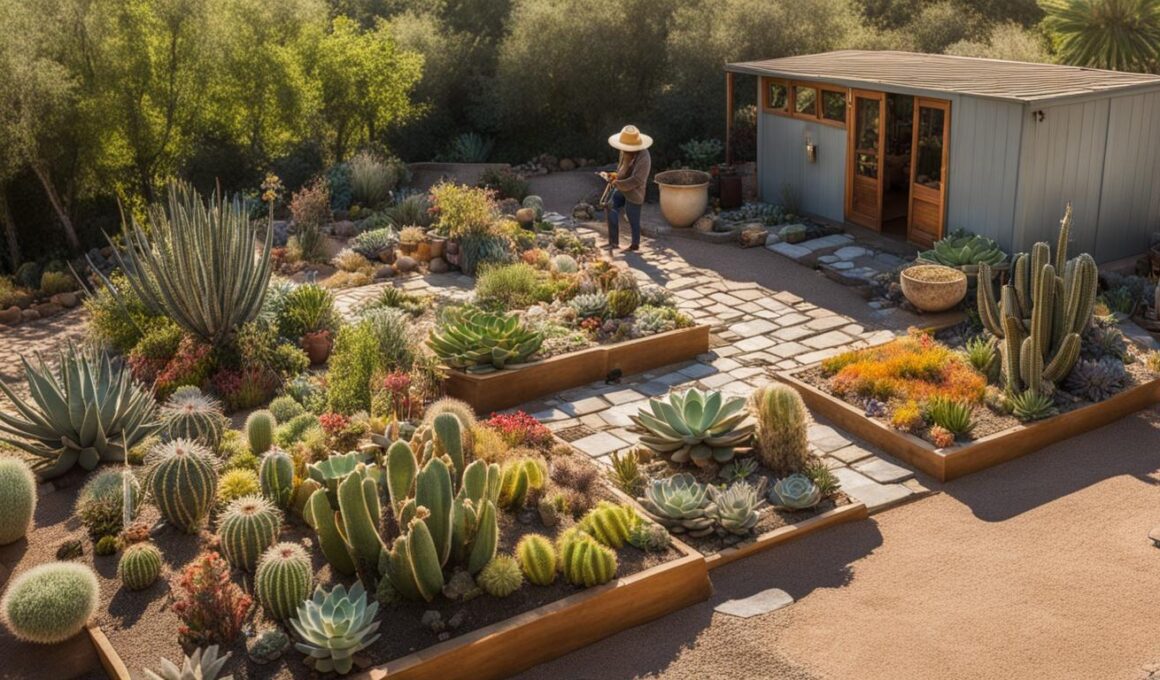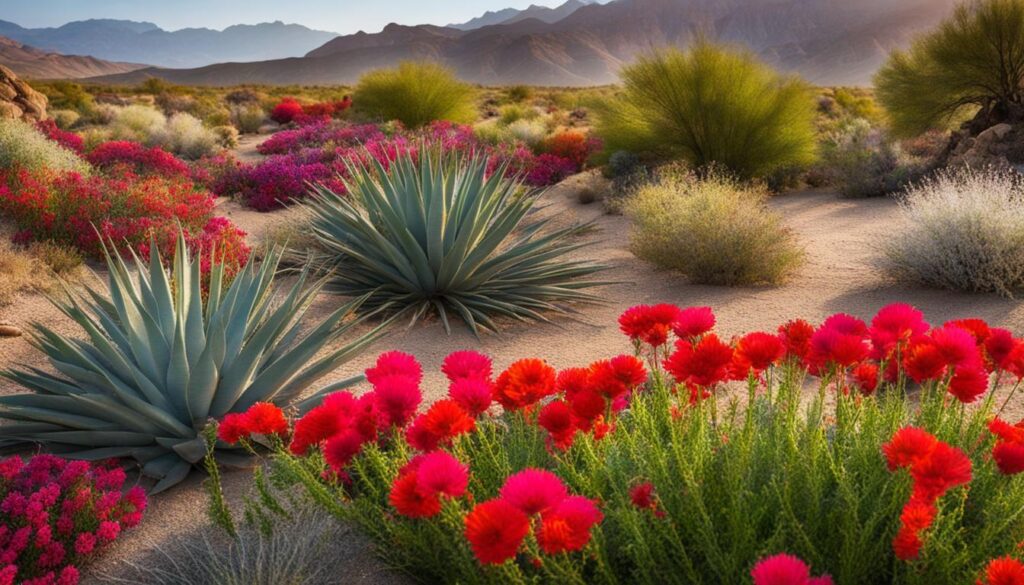Xeriscaping has gained popularity as an environmentally friendly and low-maintenance landscaping solution. By incorporating drought-tolerant plants and native species, you can create a beautiful garden that conserves water and requires minimal upkeep throughout the year. In this section, we will explore essential tips and techniques for maintaining a year-round xeriscape garden.
Key Takeaways:
- Choose drought-tolerant plants adapted to your region’s climate.
- Incorporate rock gardens and ground cover plants as turfgrass alternatives.
- Install efficient irrigation systems like drip irrigation for water conservation.
- Maintain fertile soil, control weeds, and balance sun exposure for optimal plant growth.
- Consider professional assistance for expert guidance and maintenance services.
What Is Xeriscaping and What Are Its Benefits?
Xeriscaping is a style of landscaping that focuses on using drought-tolerant plants and thoughtful irrigation systems to minimize water usage. By incorporating native plants and reducing the reliance on turfgrass, xeriscaping offers several benefits, including water conservation, lower water bills, vibrant landscapes, and attracting pollinators.
One of the key benefits of xeriscaping is water conservation. By planting drought-tolerant species, xeriscapes require significantly less water compared to traditional lawns and gardens. This not only helps conserve water, but it also reduces water bills, making xeriscaping a cost-effective option in the long run.
Xeriscapes also offer vibrant landscapes throughout the year. By selecting native plants and designing the landscape with careful consideration of color, texture, and height, xeriscapes can create visually appealing outdoor spaces that thrive in various seasons. Additionally, xeriscapes attract pollinators such as bees and butterflies, contributing to the overall biodiversity and ecological health of the area.
Overall, xeriscaping is an environmentally friendly and sustainable approach to landscaping that not only conserves water but also creates beautiful and resilient outdoor spaces that enhance the surrounding ecosystem.
- Benefits of xeriscaping:
- Water conservation
- Lower water bills
- Vibrant landscapes throughout the year
- Attracts pollinators
“Xeriscaping is a style of landscaping that focuses on using drought-tolerant plants and thoughtful irrigation systems to minimize water usage.”
Water Conservation in Landscaping
Water conservation is a significant aspect of xeriscaping. By reducing the reliance on water-intensive plants and turfgrass, xeriscapes can significantly minimize water usage. This is achieved through several strategies, including:
- Planting drought-tolerant species that can thrive with minimal water.
- Designing efficient irrigation systems, such as drip irrigation, to deliver water directly to the roots of plants.
- Using mulch to retain moisture in the soil and reduce evaporation.
- Implementing proper soil preparation techniques to improve water absorption and retention.
By following these water conservation techniques, xeriscaping allows homeowners to create beautiful landscapes while minimizing their impact on the environment and conserving water resources.
Creating a Xeriscaped Lawn: Choosing the Right Plants and Features
When it comes to creating a xeriscaped lawn, one of the most important factors to consider is choosing the right plants and features. By selecting drought-tolerant plants and incorporating specific elements into your landscape design, you can create a stunning and water-efficient outdoor space.
Choosing Drought-Tolerant Plants
When selecting plants for your xeriscaped lawn, it’s crucial to choose species that are adapted to your region’s climate and require minimal water. Drought-tolerant plants, such as succulents, Mediterranean herbs, and native wildflowers, are great options. These plants have evolved to thrive in arid conditions and can withstand extended periods of dryness without compromising their beauty.
Incorporating Rock Gardens and Ground Cover Plants
In addition to choosing the right plants, incorporating rock gardens and ground cover plants can enhance the aesthetics of your xeriscaped lawn while reducing water usage. Rock gardens not only add visual interest to the landscape, but they also provide excellent drainage and help retain moisture in the soil. Ground cover plants, such as creeping thyme or ice plant, can serve as natural mulch, keeping the soil cool and preventing weed growth.
Exploring Turfgrass Alternatives
Another consideration when creating a xeriscaped lawn is exploring alternatives to traditional turfgrass. While turfgrass requires regular watering and maintenance, there are several turfgrass alternatives that can provide a lush and green look without the high water demands. Consider options like ornamental grasses, clover, or native grasses, which require less water and mowing.
By carefully selecting drought-tolerant plants, incorporating rock gardens and ground cover plants, and exploring turfgrass alternatives, you can create a beautiful and sustainable xeriscaped lawn that conserves water and thrives in even the most arid climates.
Efficient Irrigation Techniques for Xeriscaping
When it comes to maintaining your xeriscape garden, efficient irrigation is key. By implementing the right techniques, you can ensure that your plants receive adequate water while minimizing waste. One effective irrigation system for xeriscaping is drip irrigation. This system delivers water directly to the roots of your plants, reducing evaporation and runoff. It’s a highly efficient method that can save up to 50% more water compared to traditional sprinkler systems.
Grouping plants with similar water requirements is another smart strategy for optimizing water usage in your xeriscape garden. By creating irrigation zones based on the water needs of different plant types, you can tailor your watering schedule accordingly. This allows you to avoid overwatering or underwatering certain areas, promoting healthier growth and conservation of resources.
Drip irrigation is a highly efficient method that can save up to 50% more water compared to traditional sprinkler systems.
Water-Saving Techniques
In addition to using drip irrigation and grouping plants with similar water requirements, there are other water-saving techniques you can implement in your xeriscape garden. One method is mulching. Applying a layer of organic mulch around your plants helps retain moisture in the soil, reducing the frequency of watering. It also helps suppress weed growth, saving you time and effort in maintaining your garden.
Another water-saving technique is monitoring and adjusting your irrigation schedule based on seasonal changes and weather conditions. During periods of rain or cooler temperatures, you can reduce the frequency and duration of watering. This prevents water waste and ensures that your plants receive the right amount of hydration.
Efficient irrigation techniques are essential for maintaining a healthy and thriving xeriscape garden. By implementing drip irrigation, grouping plants with similar water requirements, and utilizing water-saving techniques such as mulching and adjusting watering schedules, you can conserve water while enjoying a beautiful and sustainable landscape.
Essential Maintenance and Care for Xeriscape Gardens
Proper maintenance is key to keeping your xeriscape garden healthy and beautiful. By following these essential tips, you can ensure that your drought-tolerant landscape thrives throughout the year.
Fertile Soil Maintenance
One of the foundations of a successful xeriscape garden is maintaining fertile soil. Regularly adding organic matter, such as compost or well-rotted manure, can improve soil structure, retain moisture, and provide essential nutrients for your plants. It’s important to check the pH level of your soil and make any necessary adjustments to create an optimal growing environment for your chosen plant species.
Weed Control
Weeds can quickly take over your xeriscape garden if not properly managed. Implementing a weed control strategy is crucial to keep unwanted plants at bay. Regularly inspect your garden for weeds and remove them promptly, making sure to pull them out by the root. Mulching can also help suppress weed growth by preventing sunlight from reaching the soil and inhibiting weed seed germination.
Sun Exposure for Plants
Understanding the sun exposure needs of your plants is essential for their survival and growth. Some plants thrive in full sun, while others prefer partial shade. Pay attention to the sun patterns in your garden and position your plants accordingly. You may need to provide shade for more sensitive plants during peak sun hours to prevent sunburn and heat stress.
Common Misconceptions and FAQs about Xeriscaping
Despite the numerous benefits and growing popularity of xeriscaping, there are still some common misconceptions surrounding this environmentally friendly landscaping practice. Let’s debunk these misconceptions and address some frequently asked questions about xeriscaping.
Misconception: Xeriscaping means having a bare and rocky lawn
“Many people mistakenly believe that xeriscaping results in a dry and barren landscape filled with rocks and cactus. However, xeriscaping can be vibrant and lush, incorporating a variety of drought-tolerant plants, flowers, and even trees. By carefully selecting the right plant species and incorporating creative design elements, a xeriscape garden can be as visually appealing as any traditional garden.”
Frequently Asked Questions about Xeriscaping
- What is the cost of xeriscaping?
- How do I prepare my lawn for xeriscaping?
- What are some ideas for xeriscaping customization?
It’s important to address cost concerns related to xeriscaping, as it varies depending on factors such as the size of the area, plant selection, and additional design features. While there may be upfront costs involved, the long-term benefits, including reduced water bills and lower maintenance requirements, often justify the investment.
Preparing your lawn for xeriscaping involves removing existing turfgrass, improving soil quality, and planning the layout of drought-tolerant plants and features. It’s advisable to consult with a professional or refer to xeriscaping resources for specific steps tailored to your region and climate.
Lastly, the possibilities for xeriscaping customization are virtually endless. Whether you prefer a desert-themed landscape, a Mediterranean-inspired garden, or a mix of native wildflowers and grasses, there are countless xeriscaping ideas to suit your style and preferences.
How Can I Maintain a Xeriscape Garden During a Drought?
To care for xeriscape during drought, make sure to water your plants deeply but infrequently to encourage deep root growth. Mulch your garden to retain soil moisture and reduce evaporation. Choose drought-tolerant plants and maintain them with minimal pruning and weeding. Consider using drip irrigation to minimize water usage.
Professional Help for Xeriscape Garden Upkeep
If you find yourself needing assistance with the upkeep of your xeriscape garden, there are professionals available to lend a hand. Landscape designers and xeriscape specialists have the expertise to guide you in choosing the right plants, designing your landscape, and implementing efficient irrigation systems. They can help you create a beautiful and sustainable xeriscape garden that thrives throughout the year.
With their knowledge of native plants and drought-tolerant species, landscape designers can help you select the perfect combination of plants that will not only survive in your region’s climate but also add aesthetic appeal to your garden. They can create a custom design that incorporates features like rock gardens, ground cover plants, and pathways to enhance the overall look and feel of your xeriscape garden.
Xeriscape specialists, on the other hand, specialize in the maintenance and care of xeriscape gardens. They can provide valuable services such as adjusting water levels in your irrigation system, fertilizing the soil, identifying and removing weeds, and pruning plants as needed. Their knowledge and experience can ensure that your xeriscape garden remains healthy and vibrant throughout the year.
By enlisting the help of these professionals, you can save time and effort in maintaining your xeriscape garden while ensuring that it continues to thrive. Whether you are starting from scratch or need assistance with an existing xeriscape garden, landscape designers and xeriscape specialists can provide the professional assistance you need to create and maintain a beautiful and sustainable landscape.
Conclusion
Maintaining a year-round xeriscape garden doesn’t have to be a daunting task. By implementing efficient xeriscaping techniques, you can effortlessly upkeep your drought-tolerant landscape and enjoy the benefits of sustainable landscaping. With the help of landscape professionals, you can create a vibrant and environmentally friendly outdoor space that thrives all year long.
Remember, the key to successful year-round xeriscape garden upkeep is to choose the right plants and features that are adapted to your region’s climate and require minimal water. Incorporating drought-tolerant plants, rock gardens, and ground cover plants can not only conserve water but also enhance the aesthetics of your landscape.
In addition, efficient irrigation techniques, such as drip irrigation systems and grouping plants with similar water requirements, can optimize water usage and save time. Regular maintenance, including fertile soil maintenance, weed control, and proper sun exposure, will ensure your xeriscape garden remains healthy and beautiful.
By following these tips and techniques, you can create a sustainable and visually appealing xeriscape garden that will be the envy of your neighborhood. So, start implementing these efficient xeriscaping practices today and reap the rewards of a year-round beautiful and low-maintenance landscape.














